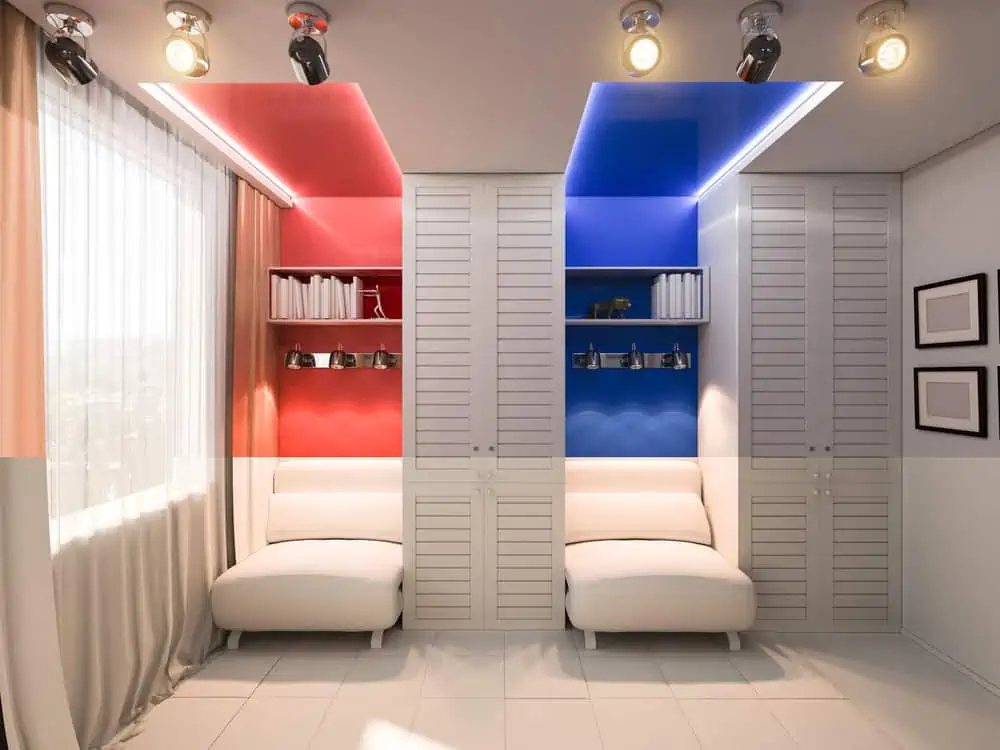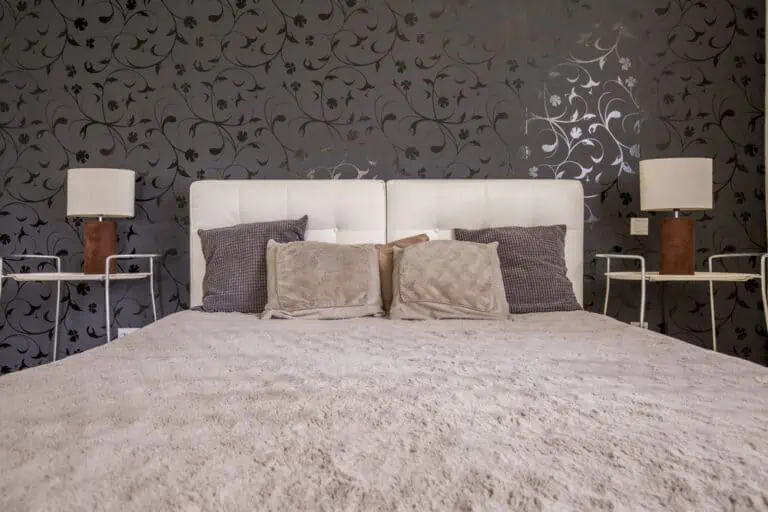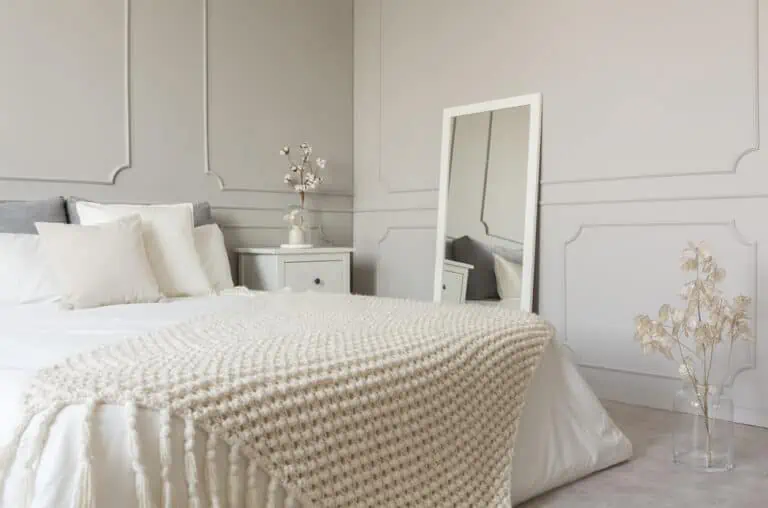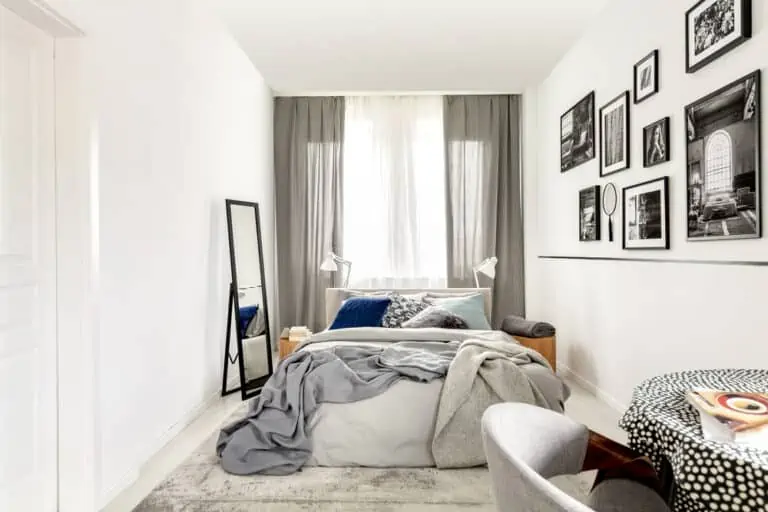How to Arrange Two Twin Beds in a Small Room (And Some Layout Ideas)
Homebody Forever is reader-supported. We may receive a commission if you make a purchase through a link on this post.
Small bedrooms are tricky to work with, and even more so when you have to fit in two twin beds. But there is a way to do it without sacrificing cozyness and comfort.
The key is to try out different configurations and layouts. Measure, sketch and play around with your room layout before you purchase beds and furnishings. Prioritize storage and search online for unique ways to utilize your space.

Before I share several layout ideas, mull over these two questions—Would you describe your room as square or long and narrow? Do you want to use the space for your children or guests?
How you want to use your space will affect the layout you eventually choose. Yes, it can be a configuration nightmare, but if you’re somewhat organized and have a couple of smart ideas to work with, fitting twin beds in a small room can be easy.
Here are seven layout ideas you may want to consider for your small space.
The classic parallel or side-by-side layout
You’ll most likely come across this sort of layout repeatedly. This is a very popular layout for guest rooms and works particularly well in rooms with a squarer shape.
Typically, with a parallel layout, the two twin bed headboards will lie against the same wall and be separated by a nightstand, desk, or dresser. If your room isn’t square, place the bed headboards against the widest wall to maximize space on both sides.
I will say that for this type of layout, it’s best to add add just one nightstand or piece of furniture when you divide the two beds. This will help the room look less cramped and crowded.
When shopping for a nightstand or furniture, look for options that offer enough storage space for two people. Two separate drawers or cupboards allows each person to have their private storage area.
Parallel against opposite walls
If your small room is small (but not tiny), try positioning your twin beds on opposite walls of the room. You can also add a minimalist nightstand next to each bed for storage.
This option works well for children that want their own space and do not want their brother or sister encroaching on their style. A good idea if you regularly experience what can only be described as two cats fighting when you pass by their bedroom.
Twin beds on opposite walls open up the center of the room, offering more space. Better still, if there is a window in the center of the wall, the light creates a fantastic airy illusion of space.
This is a good option for children or guests if your room is on the small side.
L-shaped bed configuration
An L-shaped bed fits snugly into the corner of a smaller room without wasting any space. Built-in L-shaped beds often come with a shared nightstand or counter in the corner where the two beds meet. This is great for storage.
You can also look for L-shaped beds with under-storage, which can be massively helpful. You can save even more space by slipping part of one of the beds under the other when making your L shape.
This layout usually gives you more free space in the center of a room, making it ideal for young children needing a place to play. By facing the beds toward one another, bedtime chats become more sociable, and night-time scares may be a thing of the past.
Push the twins together
Have you tried pushing your two twin headboards together against the same wall? This is a relatively traditional way of configuring twin beds and is great if you have a small adult or guest room.
What I like about this option is that adding a large quilt or bedspread over the two beds will make it look like you have one King or Queen size bed instead of two twin beds.
This is an excellent option for adults who enjoy their own space but sleep next to one another. They can shuffle and move as much as they want without disturbing their peacefully resting partner.
Two loft beds
Loft beds are excellent for younger children or teenagers sleeping and living in the same room.
By placing your loft beds on opposite walls, your children can enjoy having their own space, and the room won’t look too cramped. A loft bed is usually raised high up so there is enough space underneath for a desk, play, or relaxation area.
Before buying loft beds, ensure your room ceiling is high enough for your child to sit safely and comfortably without knocking their heads.
Twin bunk beds
A bunk bed can be a huge space saver in a small room where you need to sleep two or more individuals. As with the loft bed, ensure your ceilings are high enough to accommodate a bunk bed.
Bunk beds are a firm favorite for children sharing a room, and you’re guaranteed not to have any grumpy opposition when buying one. Of course, unless you have a teenager—I can’t promise you anything!
A clever trick for smaller rooms is to look for bunk beds with under-bed storage or a trundle bed. This instantly gives you more storage space, and the trundle bed works perfectly if you have sleepover-loving children.
If you can’t find a bunk bed with storage or don’t want to spend the extra money, think about adding risers to the bottom of the lower bunk to free up some space.
You can tuck baskets and modern plastic containers under the bed for storage—a great way to stow away children’s toys, arts and crafts, or knick-knacks.
End to end
Choose the longest wall in your room and place both beds end to end, so they face one another. This works well in a small children’s room that isn’t square-shaped.
By pushing the beds together, you don’t waste any room space and open up the rest of the room for other uses. Use the open space as a play area. Add some beanbags or a small table and chairs for the children to do their crafts. The options are endless.
Before you choose your layout…
I know planning and sketching may feel like a drag, but I can’t emphasize how important this is!
So how does one start?
Get that measuring tape out, measure every wall, door, and fixed item or furniture in your room, and sketch it out. Please don’t forget to measure the room’s height if you are considering bunk beds.
A ceiling height above 8 inches (20 centimeters) should work for a bunk bed, but the higher, the better. You need at least 33 to 36 inches (84 to 91 centimeters) of space between the top bunk mattress and your ceiling.
Now, this is where the fun begins. Measure your twin beds out on paper and cut them out so you have two twin bed cut-outs you can work with. If you don’t already own twin beds that you can measure, work on these standard twin bed dimensions of 38 inches by 75 inches (97 by 191 centimeters).
After this process, you’d have completed a simple sketch of your room and two twin bed cut-outs. Play with the bed layouts on your sketch and see which gives you the most space and the better overall feel.
If you’re anything like me, it can be tough to visualize a space without physically seeing it right before you. Sketching and measuring helps to give you a better idea of what you can expect and make bed layout decisions much simpler.
Some extra advice
Getting easily muddled and flustered when fitting two twin beds in a small room often happens and is not uncommon. Hopefully, one of the seven layouts above can ease some of your anxiety.
But first, here are a couple of points to keep in mind before getting stuck into your bedroom design.
Color and décor
If you can, keep the wall color in the room simple. Don’t get overly excited by adding too many colors. One or two colors will open up the room and make it look less cramped.
If you have two children sharing a room, keeping a symmetrical and consistent theme or color in their bedding and walls may be challenging. If you can, try to keep the headboards and bedroom furniture the same.
Keeping a standard look and feel in the room will make the room appear less tiny and more pleasing to the eye.
Bed position
Consider positioning beds away from the doorway. The greater distance between them can help to give the appearance of more space.
Storage
This is a biggie in terms of room layout. Small rooms demand clever storage solutions. Think shelving, bed risers, and under-bed storage. Adding a storage chest or similar to the end of your twin beds is a simple way of remedying a storage problem.
If you can afford to purchase custom twin beds with built-in storage, you will not regret it. The more storage space you can add to a small room, the better.



